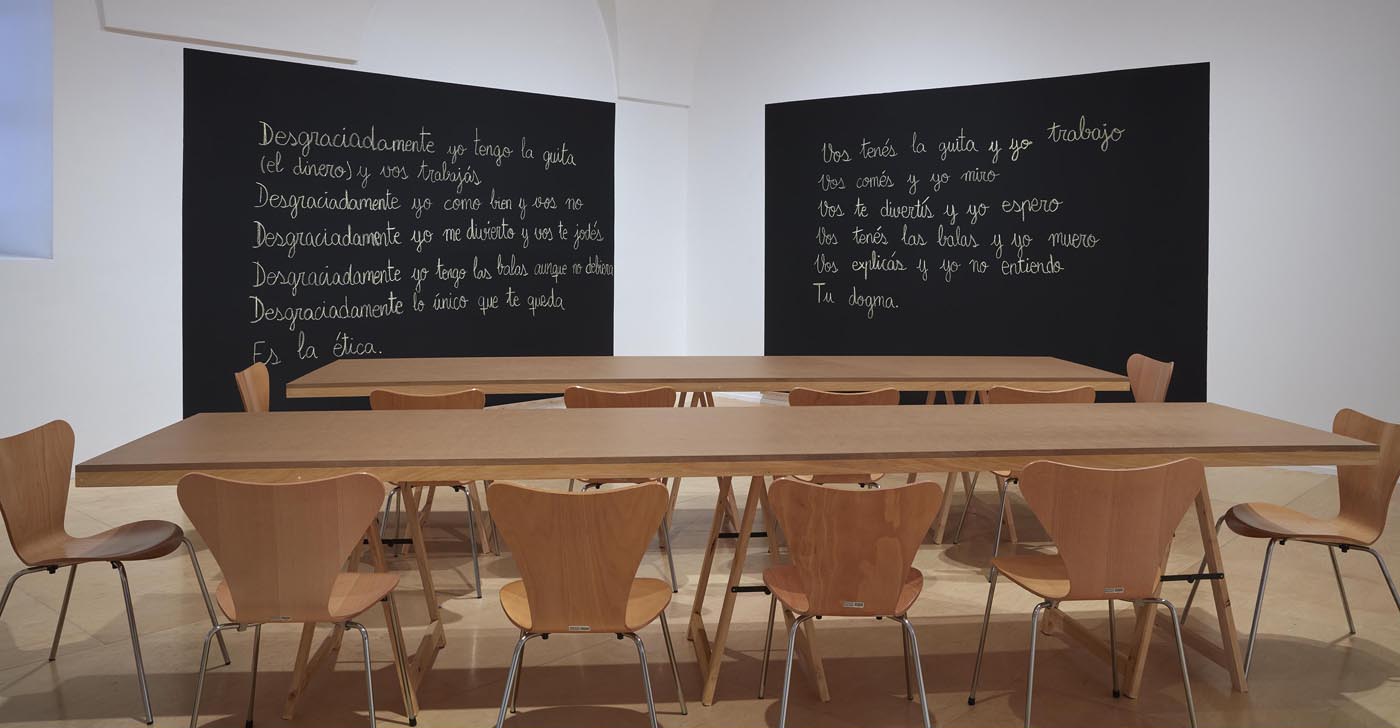Miguel Braceli: I would like to begin by talking about Latin American conceptualisms and the pedagogical dynamics that were present in the art produced in the second half of the 20th century. These approaches converge and intertwine in many points, one of them being art as a way of acting and not as a way of producing. How do you see this relationship between Latin American conceptualisms and pedagogical practices? What made those artists educators?
Art and Education Are Enriched if they Assume Responsibilities
06/07/2022
with Luis Camnitzer
Miguel Braceli talks with Luis Camnitzer about the place of art as education today, the tradition of artist-run schools in Latin America, access to public education, and the need for art to transcend the institutional space in order to generate tangible social changes.
Luis Camnitzer (Lübeck, Germany, 1937) is an Uruguayan conceptual artist, teacher, and theorist whose work is essential for understanding the relationship between art and education. Based in New York (USA) since the 1980s, Camnitzer has reflected on, developed, and directed numerous projects in which the boundaries between pedagogy and artistic creation are blurry.
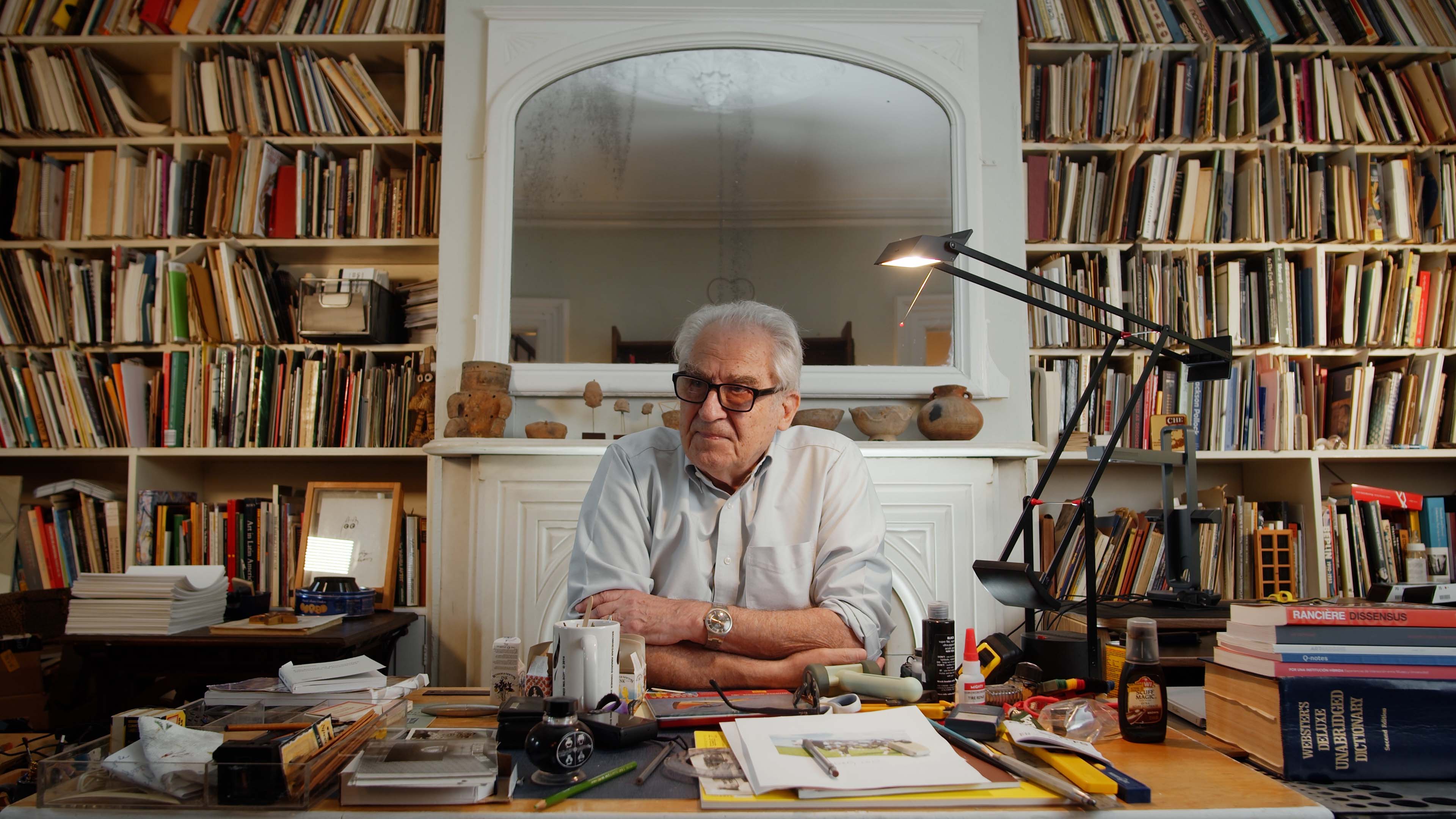
Luis Camnitzer: I wrote a book called Conceptualism in Latin American Art: Didactics of Liberation, which traces the origins of Latin American conceptualism back to Simón Rodríguez and not to people like [Joseph] Kosuth. The reason for this is very clear: there is a kind of imperialist concept of what art is and how it is made, which overlooks ways how several knowledge and production methodologies are developed in non-central countries. In the times of Simón Rodríguez, it was all about how to communicate things with minimum notions, which at the beginning of the 19th century was the concept itself — a need that arose in the metropolitan cultures by the 1960s. That, for me, determined several things: the economics of presentation and the need to be true to what you want to achieve. In the case of Simón Rodríguez, the fascinating thing is that he used the whole page layout design to reflect how he was thinking, not just what he was thinking, and to reproduce that in the reader’s mind. That, for me, is the paradigm of being an artist: how to enter the viewers’ minds to take them in a direction that I want them to go.
Within that, there are two possibilities: one that begins with a process of indoctrination towards spectators, to submit them to my ideas, and another to generate a new process that departs from the spectators and begins to stir in them a direction that, for me, is of liberation. That process is essentially political. Within the artistic field, where politics served to illustrate and narrate, in the case of Simón Rodríguez regarding the Latin American situation of colonialism, the process changed and became one of education. How to educate the public to be free, not to have a pre-digested set of idea? How can they generate their own views?
Once you put it that way, obviously, the separation between art and education starts to become quite blurry. They are both enriched if they assume responsibilities: if art takes responsibility as a cognitive instrument and if education takes on the responsibility of liberating the students as individuals and training them to be able to have their own ideas. That is more or less the picture.
Considering the recurrent use of both terms, what is the difference between ‘art education’ and ‘art as education’?
There is a problem with the content we assign to the word ‘art.’ We conventionally assume that art is a form of production within which professionals are trained to make “the best possible art,” that which will go to museums. In a way, the museum is the architecture of the artist's posterity. Whether we like it or not, professional artists aspire to be in a museum, even if they are against museums. The museum accepts everything that challenges it from the outset to take advantage of it. That is the very traditional vision of what art is. It also comes from artisanship: the history of art is a history of artisanship, in which the artisan who stands out, the virtuoso, adds one more undefinable element, and thus, we end up calling it art.
Then there is art as a cultural agent that affects the collective culture. So the separation would actually require two different words: one for art as production and another for art as a cultural agent, but we have not been able to get people to grasp that separation. In terms of cultural agency, the author and even posterity are ultimately the least important things. What matters is how you affect the collective consensus regarding the dispositions necessary to survive appropriately in society. This can be by submitting them to a pre-existing order or by questioning the orderings that exist, constantly reviewing them, seeing which ones are valid and which anachronistic or negative.
When we talk about the survival of a society, the difficulties of coexisting collectively become implicit. Many of your educational projects focus on the definition of problems. Could you tell us more about that? How can education and art meet in problem-solving?
If art is a way of knowing, that means that you have to formulate the problems you want to solve. In art, it is a little more complicated because if we talk about the formulation of a problem in general, we assume that it is something completely rational, following cause, effect, and logic; that is, we are biased by scientific thinking. But art can incorporate the absurd because it is impossible — one of the definitions of art is, essentially, that it serves no purpose. That might seem negative, but deep down, it outlines a field of unlimited freedom, which is more conditioned by what you don’t know than by what you do know. It is there where art as education is fundamental because it allows to bring about an educational process in failure, in the absurd, in the speculation of what cannot be. Let's see, why can't it be? Who determines that it cannot be? Who sets the limits and who cares about these limits? Where do these limits work against you instead of in your interest? In this sense, education is a constant political process. Not as a political ideology attached to the activity, but it is indeed a political part of the process.
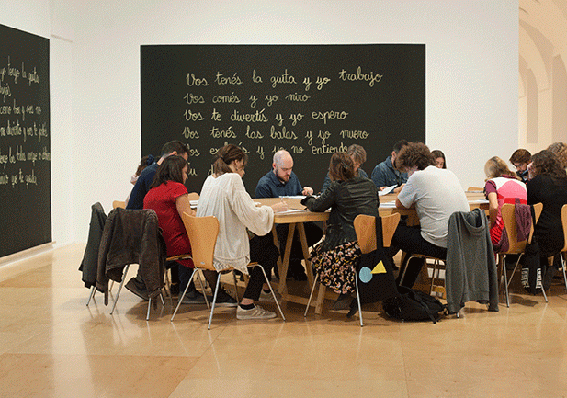
Regarding art as a driving force for change, today there are numerous movements defined as ‘social practices,’ ‘participatory art,’ or ‘community projects,’ among others. All these proposals coincide in education, but how does education become key to these practices? And why is the term ‘education’ displaced, anyway?
I have gained quite a few enemies with this, but for me, most art as a social practice is embellished social service, which ultimately acts in favor of the artist and not for the community. There is very little art as a social practice that works with what is not known, and for me, one of the missions of art is to explore the unknown, what we do not know. And to have the ability to continually rearrange things. In most cases, art as a social practice is not devoted to exploring the unknown but to improving the standard of living within the known parameters. That does not interest me as art but as a social service.
And in that sense, isn't education a possibility to generate a transformative reality?
That is fulfilled at school. That is where it is needed. The fact is that school does not actually educate you, it trains you. It trains you for the functioning society, which is set up to produce hubs for some people. Then you are paid to function properly within that system; you are chosen in meritocratic terms, for doing better. Those who do not do well are discarded.
Education focuses on the growth of the individual, on integrating them into society constructively and dynamically, continuously questioning what is happening, so that it does not occur again. And whatever happens, it will be the best for the community.
For the last decades, there has been an interest in understanding the possibilities of art in education. However, it seems to be an idea that varies in its propositions, interest, and understanding within the art world. Why has the proposal of art as education not been able to consolidate itself like many other movements?
In a way, the problem is that we continue to use the word ‘art,’ and this term is so contaminated by the purpose, the product, the market, the exhibition, that it is very difficult for it to stand for itself in the other field. If its focus was outside, in education, and we were to forget the word art for a moment and ask ourselves, why is education failing? It is failing because it is not creative and does not train people to be creative, because it selects people according to certain measures and does not allow the qualitative development of the individual regardless of whether someone is better or worse, regardless of a final grade. I believe that if we focused on that part, it would stick around. The other only creates a fad.
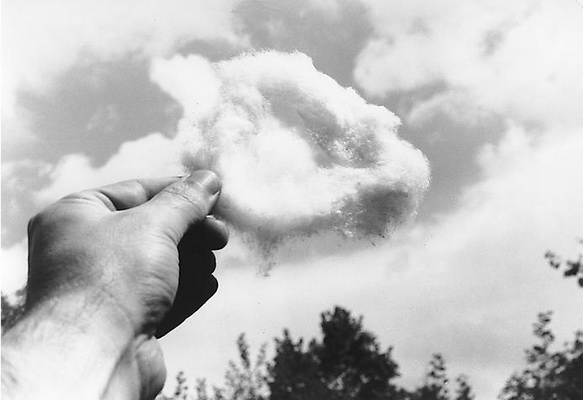

You have recurrently insisted on the fact that education (and art) must be in dialogue with its surrounding reality "to see what we can be done" with it. There is a highly political act in this premise, in the very act of learning and discovering, of influencing a given territory and reorganizing it. What do you consider the surrounding reality of education in Latin America?
I would say that reality is much more complex than what we attribute to words. Reality is not only the socio-economic or socio-cultural conditions in which we operate but also the ability to imagine within those conditions. Education must consider that and discover intersections to get out of it.
Latin America is intricate. It is a very tricky word because it tries to unify something that is not unifiable. It ignores social classes and accepts— though not entirely — the colonial situation. For me, the person who is most clearly articulating this situation is Boaventura de Sousa, when he speaks of Northern epistemologies versus Southern epistemologies. It is a way of separating the countries not from a geographical perspective but from the cognitive aspect of societies, thus transcending geographies.
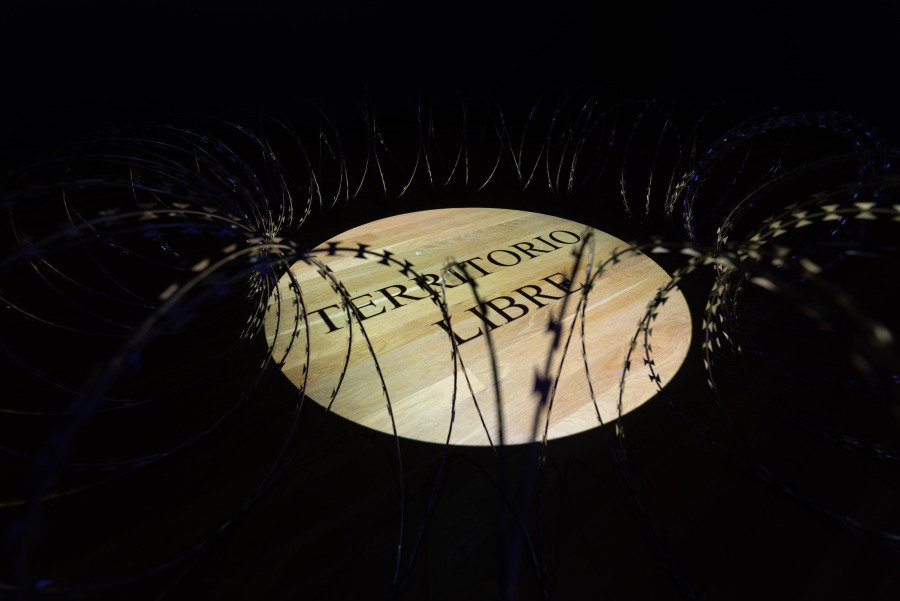
When talking about Northern and Southern epistemologies, you play an important role: you are a South American artist who has spent most of his life in North America, exercising your artistic practice on a global scale, but above all, teaching in the United States. What do you think these two Americas can learn from each other?
There was a time when I thought the difference was inventiveness: in a culture of poverty, we develop an ingenuity to survive that does not arise in a culture of wealth. At the same time, ingenuity is relevant within attuned cultures; especially now, the whole theory of "thinking outside the box" stimulates inventiveness. And STEM, which is science-and-technology-based education, is all about ingenuity. But to me, this division is not enough.
Such inventiveness focuses on rearranging known things in order to increase their effectiveness and, ultimately, increase luxury. Luxury can be monetary or the functionality of a given situation. But inventiveness is not applied to things we do not know and that is where we are failing, both in the North and in the South. In the South, we have more liberties, in the sense that we are less tied to rationalism, but at the same time, that also opens the door to obscurantism, superstition, and other things that are not so good either. The ideal educational process is more global and less North-South than we are proposing.
There is a valuable lesson in the South, which is the presence of public universities, free of charge. These are institutions attuned to their realities, which at the same time makes them sensitive to them. However, they are an increasingly precarious and less sustainable system. How could we make public and free education more sustainable?
Education must be public, period. It is a false dilemma. Private education is nonsense, since it is based on the idea that education is something marketable and purchasable, which in turn stimulates social stratification ("public education for the poor, private education for the rich").
For me, it is of the essence to de-privatize education all over the world, not to privatize education in Latin America. Unless we come to believe it is quite all right to have a social class that has access to things and others that do not. But I doubt that anyone would deign to say, "Yes, that is quite all right."
In your essay “La enseñanza del arte como fraude” [Art Education as Fraud] you end up emphasizing the need for a structural change in society that will, in turn, allow us to take on and finance this task. We are beginning this new century with a radical change of global proportions. In this transformative scenario, what can art and society do for education?
The issue of art education as a fraud was only directed at artistic professionalization. Today, in the US, getting the final degree on an MFA can cost you US $200,000. Being an artist, you then have no way to have the income to pay the debt of your studies. So that is the fraud, that very few people actually make it. Meanwhile, 95% of those who study arts end up hoping to teach art. Therefore, every one of those failed artists will need a group of students who fall into debt to the same extent.
The fraud that you speak of, is it an economic fraud (because the artist cannot practice), or an academic fraud (because art cannot be taught)?
It is a pyramidal scheme. The one atop is saved, but he builds a pyramid of support that is not, and those who end up at the bottom end up doing things that have nothing to do with art. They wasted their time in an education that could have taught them imagination, but not even that.
Another problem is the separation of artistic thinking from the formulation of complex problems, those of utmost complexity. Namely, knowledge not circumscribed to cause and effect and predictability; that is not in the process. There is an emphasis on instrumentalization, on achieving useful outcomes. When you decide to navigate the world of predictability, if you discover something you did not know, afterward, you retroactively realize that it was predictable. It did not open the gates to the unknown for you but of the not-yet-known, of the conceivable. That is a very narrow and partial universe.
Even in art schools, the intrinsic possibilities of learning are curbed too. In science, academia is one of the main places of experimentation, from which the outside world gets nourished. But art schools follow museums, what happens outside, instead of turning to academia as a source of knowledge.
The problem is that the public university competes with the private university, so there is not enough power to support the humanities as a need of knowledge. But it is also happening in that education: speculative science is being reduced, as funds are going to applied sciences and not to speculation. The spheres of art are being seized by subsidiary activities: consultancy, gallery management, curatorship, administration, or technical skills, instead of generating new problems... Unless it is a very top-level — private — school.
I would like to talk about schools. Notably, in Latin America, there is a long tradition of artist-run schools and experimental projects linked to education that respond to our contexts and crises. What can we still learn from them today, and what can these models teach within a global scenario?
Frankly, I don't know how to answer that. First of all, there is the danger of competing — "the Latin American school is better than..." — and that is not the point. There are experiences such as Paulo Freire's that apply to other places, but there are also experiences from other places implemented here in Latin America. Something I realized relatively recently is that Paulo Freire was a contemporary of Latin American Conceptualism. This reaffirms my idea that to understand the Latin American art of the time, you have to understand everything: pedagogy, poetry, liberation theology. I had never thought of Freire as part of my generation (he was older), but mentally he was.
How do you see Simón Rodríguez in regard to that generation?
I see him as an unavoidable precedent, different from [Johann Heinrich] Pestalozzi, who was the reference in Europe. Personally, I always say that Simón Rodríguez is the only historical figure with whom I would like to sit down to have coffee; the others do not interest me too much. And that is because of his clarity, even if he did not explain it; he had a quite explicit concern for decolonizing, a concern for not limiting himself to certain disciplines, and for opening minds.

What place do art schools have in the contemporary landscape?
Actually, the schools for professional artists do not interest me much; they are like schools for carpenters, barbers, etc. I am fine with that and have nothing against them. What I do oppose is that the entire creative and imaginative field seems to be confined to professional schools; that is the point that seems like a social barbarism to me.
As long as there is a place for people who want to be professionals, that is great. I think this place should be as open and transdisciplinary as possible and socially aware. In fact, I come from there. I was 17 when I was studying at the School of Fine Arts and involved myself in a curriculum reform process. It was not my invention, there was an entire generation behind it, and they trained me in that direction. Politically, I am still on the path of that experience. But the important thing is to change the schools, making them of common public access: deprivatizing them.
It is like breathing. If the air was privatized, would we be able to breathe? Yes, but our breath would be something that produces a profit for certain industries and social classes. We are in a field that is no longer ours, but we do not realize it. Education has to be a birthright of the people, it cannot be subjected to monetization.
From an art-education perspective, how could we transcend the creative space to generate a tangible social change?
Firstly, to become aware that it is not a competition between what you do and what other people do. Second, to encourage artistic thinking and to think in broader terms, integrating what you do not know with what you do know, and criticizing what you know.
School is set up to transmit what is known; it is an institution rooted in the past. Art is precisely what allows you to work with the future; therefore, it is absurd to exclude it from the general educational process. We have to figure out ways to use the field of ignorance, which is an extremely fertile territory that allows us to do everything, instead of limiting ourselves to certainty.
